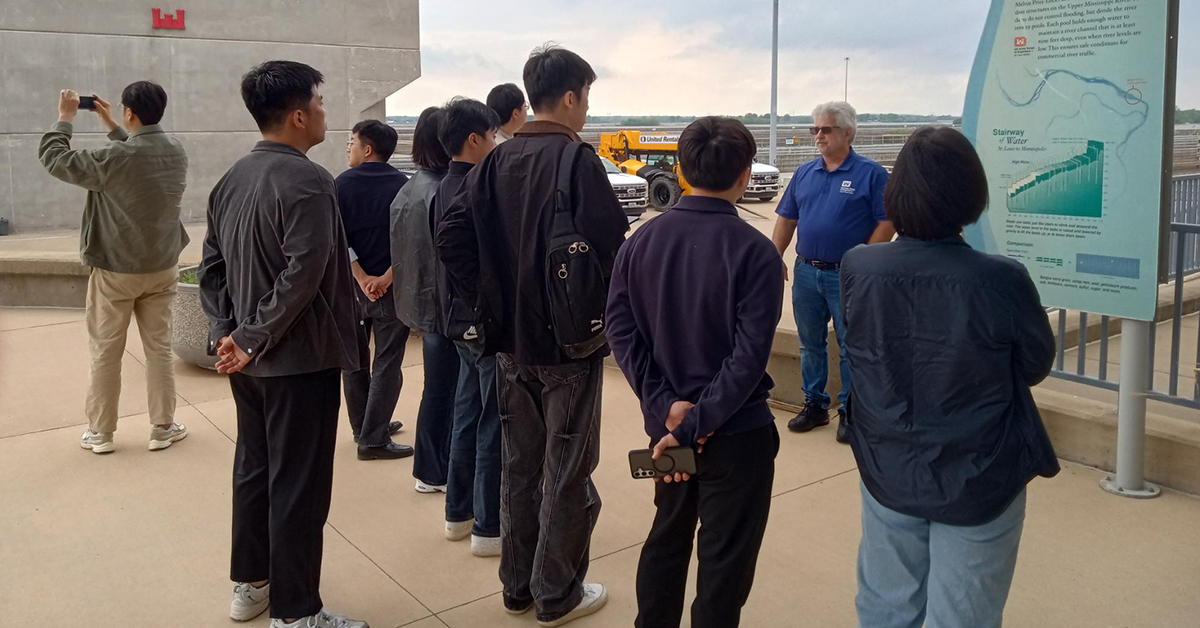For the fourth year in a row, Dr. Guy Allen, senior economist in the International Grains Program, which is part of the Department of Grain Science and Industry at Kansas State University, led a group of Korean grain buyers on an intensive, whirlwind tour of grain trading facilities, ports and ag export infrastructure in the Midwest. The itinerary tracked the Mississippi River export corridor, beginning in Chicago and ending in New Orleans.
Participants were sponsored by KOAA (the Korea Overseas Agro-Resources-Development Association), a Korean government-sponsored partner for the globalization of Korean agricultural business.
The tour began in Chicago April 28 with an agricultural overview at CME Group, the world’s leading derivatives marketplace, offering a wide range of global benchmark products across all major asset classes, including agricultural commodities. The first session was presented by Fred Seamon, executive director of the agricultural research and product development of CME Group. In the afternoon, the group visited two trading facilities: Plus500 in Chicago and brokers Advance Trading Inc., in Bloomington, Ill.
Next the group of 11 traveled by bus to Joliet, Ill., where they visited the Joliet Container Logistics Center and the DeLong Grain Company Container Terminal, as well as the Marquis Grain Company facility in Hennepin, Ill. They then toured the Illinois Grain Farm in Putnam, Ill., before winding up with dinner in Peoria, Ill., where they were joined by Robert Sinkler and Anshu Singh.
Sinkler, former commander of the Rock Island Engineer District in the Quad Cities, is a transportation consultant who has been instrumental in joining together many of the small ports and terminals in the Upper Mississippi and Illinois rivers into statistical port districts, including the Corn Belt Ports. Singh is director of sustainability and conservation at the Corn Belt Ports. The tour group visited one of the ports at Hampton, Ill.
The next day, April 30, began with a visit to Peoria Lock and Dam, followed by a bus trip to James Reid’s Yellow Dent Corn Monument in Tazewell County, Ill. Reid was a renowned farmer in central Illinois in the mid-1800s, who crossed gourdseed with little yellow corn, a northern flint, to create Reid’s yellow dent, a corn strain that increased yields and served as the basis for most of today’s varieties. Reid’s great-grandson, Matt Shipton, works in the seed industry today. A tour of Encompass Grain’s Union Pacific Railroad shuttle train loader at Allen Station, west of the elevator in San Jose, Ill., followed.
From central Illinois, the group headed to Alton, Ill., where they toured the Melvin Price Lock and Dam (Lock and Dam 26), the last lock on the Upper Mississippi River system, located at Mile 200.78 on the Upper Mississippi River, 17 miles north of St. Louis, and a key transit point for grain cargoes southbound to the Gulf Coast for export. Guided that part of the tour was Andy Schimpf, operations manager with the St. Louis Engineer District’s Rivers Project Office. Mel Price has just reopened its main, 1,200-foot lock chamber. Modernizing and completing the lift gate replacement at Melvin Price concluded the third phase in a multi-year maintenance project to improve operational efficiency and ensure navigation on the Upper Mississippi River.
That afternoon, the group visited the Gateway National Museum, under the Gateway Arch, whose exhibits detail the commercial history of St. Louis, then took a break at the Saint Louis Galleria Mall.
The group wound up its trip in New Orleans, where it visited Russell Marine Group and toured the river. The group then visited Cargill’s Reserve Export Marine Terminal in Westwego, La.
It’s a lot to take in and digest in one trip, Allen said, but he said trips like this can be very productive.
“There’s no substitute for seeing the locks and dams, and these students regularly tell me it’s their favorite part of the trip,” he said.
Allen said interest in the tours is huge, and he could easily double the number of attendees.
Featured image caption: Andy Schimpf, operations manager for the St. Louis Engineer District, explains the operation of the Mel Price Lock and Dam to a group of Korean grain buyers. (Photo by David Murray)




